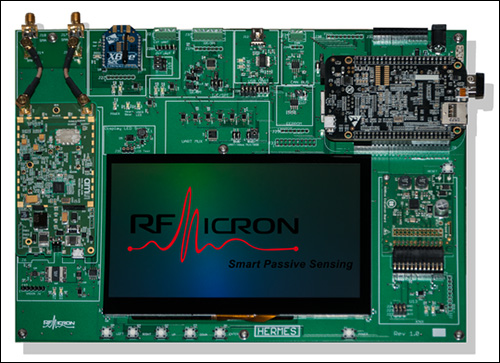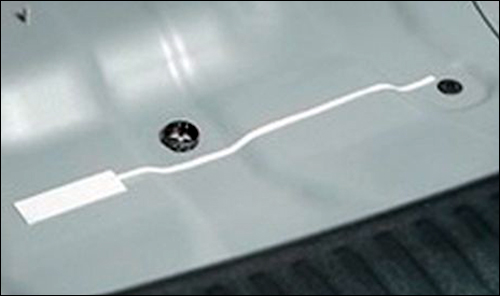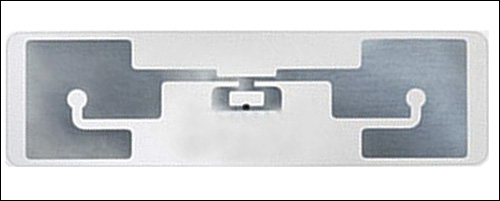SMARTRAC and RFMicron have each released new passive ultrahigh-frequency (UHF) temperature-sensing RFID inlays that they are marketing as low-cost alternatives to data loggers or active RFID tags, for use in tracking the temperatures of such products as perishable foods in supply chains or in storage. RFMicron has also released several other new products aimed at the wireless transmission and collection of sensor data. The companies announced these products at last week’s RFID Journal LIVE! conference and exhibition, held in Orlando, Fla.
SMARTRAC’s Sensor Temperature DogBone inlay and RFMicron’s Temperature Sensor Powered by Magnus tag both use RFMicron’s Magnus S3 passive RFID sensor IC, released a year ago (see RFMicron Releases New Passive UHF Chips With Moisture, Temperature, Pressure Sensors). The disposable UHF tags can be attached to items via an adhesive and is intended to enable users to identify a tagged item’s temperature when interrogated by a UHF RFID reader. The SMARTRAC inlay is a follow-up to the company’s Sensor DogBone moisture-sensing inlay, which is made with RFMicron’s Magnus S2 chip, according to Lauri Hyytinen, SMARTRAC’s head of automotive segment.
The Sensor Temperature DogBone inlay and the Temperature Sensor Powered by Magnus tag each come with an on-chip temperature-sensing circuit that digitizes a product’s temperature value into a 12-bit number. Off-the-shelf UHF readers receive that data, along with the tag’s unique identifier, and use RFMicron software to convert the 12-bit number to a temperature reading, from -40 degrees to +85 degrees Celsius (-40 degrees to +185 degrees Fahrenheit).
The Magnus S3 chip’s typical accuracy is ±3 degrees Celsius using one-point calibration, which is performed during wafer manufacturing. Alternatively, the Sensor Temperature DogBone inlay and RFMicron’s sensor tag are available with a chip that offers two-point-calibration, with which temperature accuracy is plus or minus 0.55 degrees Celsius. In addition, the new inlay retains the basic moisture-sensing capabilities found in the Sensor DogBone inlay. To do that, Magnus chips measure the impedance changes in an RFID tag’s antenna, caused by the presence of moisture or water.
The sensor tags can be affixed to cardboard, plastic, wood, stone or other construction materials. According to Hyytinen, they are intended to serve as a solution for applications in which food or other perishable items, or conditions within a room, need to be periodically monitored. He says he expects the Sensor Temperature DogBone to be used in the food cold chain, as well as for industrial, health-care, agricultural and Internet of Things applications.

The Sensor Temperature DogBone inlay has a die-cut size of 97 millimeters by 27 millimeters (3.8 inches by 1.1 inches) and an antenna measuring 89 millimeters by 24 millimeters (3.5 inches by 0.9 inch). The Magnus S3 chip complies with the EPC Gen2v2 standard and comes with a 64-bit unique tag identifier (TID), 128 bits of Electronic Product Code (EPC) memory and 176 bits of user memory.
In addition to its new Temperature Sensor tag, RFMicron has released a new Predictive Maintenance Kit to enable users to wirelessly monitor the temperatures of motors and switchgears, says Andy Lambrecht, RFMicron’s senior director of marketing. The kit comes with 75 Temperature Sensor Powered by Magnus ceramic tags, as well as a Nordic ID handheld reader loaded with RFMicron software to interpret sensor data and manage any alarms or alerts related to temperature readings outside of preset acceptable perimeters. The tags have peel-and-stick backing, enabling them to be easily affixed to a piece of equipment. These sensor tags are made with a quad-flat no-leads (QFN) package soldered to an antenna.
The kit, Lambrecht explains, is designed to enable companies that use motorized equipment to easily monitor the temperatures of their devices and thereby identify when those temperature levels might indicate a problem. For instance, equipment often begins running hotter than normal if failure is imminent. By identifying the temperature change in advance of a failure, users can replace that piece of equipment (or provide preventative maintenance) before its failure can disrupt their operations. The system, he says, offers an easy, low-cost alternative to mounting temperature loggers on equipment that must be accessed and visually viewed wherever they may be mounted on that motor or other gear.
Last week, RFMicron also released its Hermes IoT Smart Edge Development Platform to help developers create a system using devices that capture sensor data and forward it to a cloud-based server. According to Lambrecht, the solution provides the necessary horsepower to perform more critical processing and decisions locally before aggregating data in the cloud. The Hermes platform is an appliance with a Linux processor to process data from sensors and forward that information to the server. It contains a UHF reader module, a Wi-Fi radio, and USB and Ethernet ports. The system is designed for use with RFMicron’s sensor tags and chips so that sensor data could be collected from a variety of sources, and then be managed in the cloud.
Within the past 12 months, SMARTRAC released two other passive moisture-sensing UHF RFID inlays—the Sensor Tadpole and Sensor Patch—both made with RFMicron’s Magnus S2 Smart Passive Sensor IC. The Tadpole, which won this year’s RFID Journal Award for Best New Product (see RFID Journal Announces Winners of Its 10th Annual Awards), is designed for use by the automotive industry to detect the presence of moisture inside a car body after the new vehicle is sprayed with water to ensure quality control. To detect small water quantities across a wider area, the tag can be extended via a paper tail that absorbs water and transfers moisture-level information to the tag via capillary action. The SMARTRAC Sensor Patch, designed for health-care applications, is intended for use with adult diapers for geriatric patients in the health-care industry.

Several automotive companies are incorporating the Sensor Tadpole inlay and Sensor DogBone tag, as well as RFMicron pressure-detecting and moisture-sensing tags, into car seats for pilot projects. The pressure sensors in the seat can determine a passenger’s size (for instance, adult versus child), while moisture sensors in the seat back can help to determine whether an object is human or non-human, as well as ascertain the position—leaning forward or sitting back, for example. German vehicle manufacturers, including a producer of high-end cars, are incorporating the Sensor Tadpole inlay into their vehicles for pilots they are conducting (see Solutions for Automotive, Health Care and Retail: Water Leaks in Cars Can’t Hide From RFID).
Several businesses in the construction industry are currently piloting RFMicron’s moisture-sensing tag for leak-detection applications. In addition, an incontinence-management company is piloting the moisture tag for use in diaper products.




